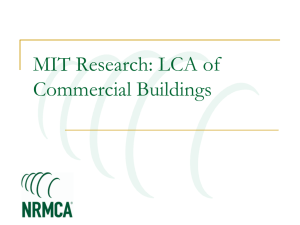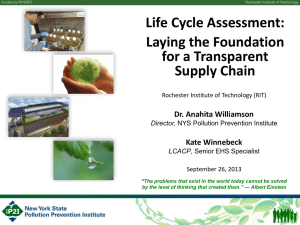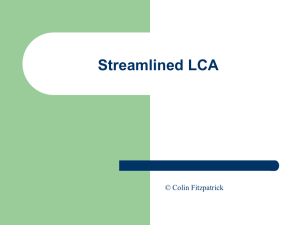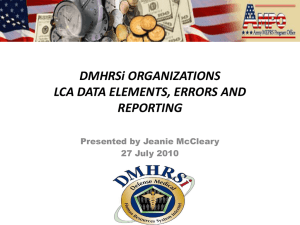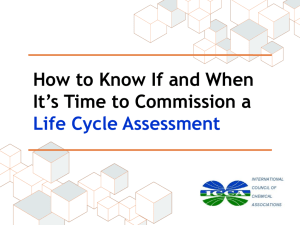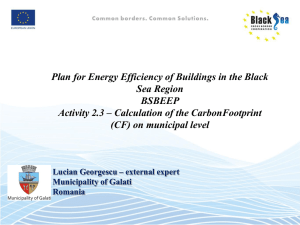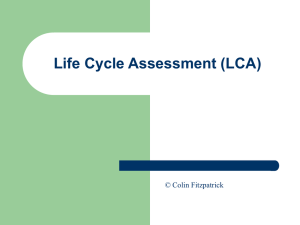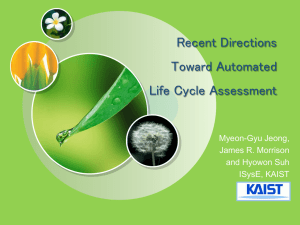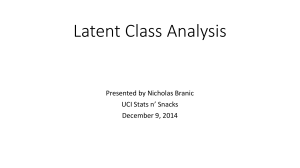Life Cycle Analysis and Resource Management Slideshow 1
advertisement
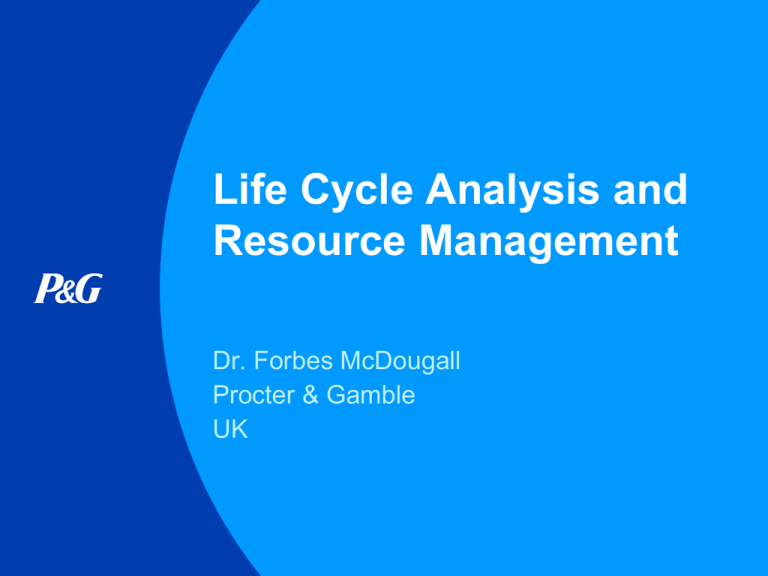
Life Cycle Analysis and Resource Management Dr. Forbes McDougall Procter & Gamble UK 2 Presentation aims: 1) Examine the use of LCA within an overall environmental management framework to assess the environmental impact of packaging options and waste management systems 2) Look at how LCA can be applied to packaging, products and waste management 3) Use LCA to help assess the cost effectiveness of specific environmental initiatives 3 Sustainability is : A balance between the needs of the Environment, the Economy and Society SUSTAINABILITY Environmentally effective Economically affordable Socially acceptable An environmental management framework OBJECTIVE Economically (and technically) Feasible, Socially acceptable, Environmental Management towards Sustainability An environmental management framework 1. Ensure Human and Environmental Safety 2. Ensure Regulatory Compliance OBJECTIVE Economically (and technically) Feasible, Socially acceptable, Environmental Management towards Sustainability 3. Ensure Efficient 4. Ensure Social Concerns Resource Use and are Addressed Waste Management An environmental management framework Regulatory Compliance Safety • Human Health Risk Assessment • Ecological Risk Assessment • Manufacturing site mgmt.. systems auditing • Manufacturing site wastes reporting • Material consumption reporting • New chemicals testing and registration • Product & packaging classification & labeling OBJECTIVE Economically (and technically) Feasible, Socially acceptable, Environmental Management • Economic analysis towards Sustainability • Product & process LCA • Eco-design • Disposal company auditing • Material consumption monitoring and reduction • Manufacturing site mgmt. systems auditing • Manufacturing site environmental auditing • Auditing major & new suppliers Resource Use and Waste Management • Understand & anticipate • Interact Addressing Social Concerns An environmental management framework Regulatory Compliance Safety • • • • • • Human Health Risk Assessment • Ecological Risk Assessment Manufacturing site mgmt.. systems auditing Manufacturing site wastes reporting Material consumption reporting New chemicals testing and registration Product & packaging classification & labeling OBJECTIVE Economically (and technically) Feasible, Socially acceptable, Environmental Management towards Sustainability • Economic analysis • Product & process LCA • Eco-design • Disposal company auditing • Material consumption monitoring and reduction • Manufacturing site mgmt. systems auditing • Manufacturing site environmental auditing • Auditing major & new suppliers Resource Use and Waste Management • Understand & anticipate • Interact Addressing Social Concerns Data Organisation DECISION MAKING Life Cycle Assessment (LCA) within the overall environmental management framework RESOURCE USE AND WASTE MANAGEMENT •Economic analysis •Product and process LCA •Eco-design •Disposal company auditing •Material consumption monitoring and reduction •Manufacturing site management systems auditing •Auditing major & new suppliers Phases of LCA (taken from ISO 14040) Life Cycle Assessment framework Goal & scope definition Inventory Analysis Impact Assessment Direct applications : Interpretation • Product development and improvement. • Strategic planning. • Public policy making. • Marketing. • Other. - included in - not study an LCI study included in an LCI 10 Decreasing objectivity and reliability across a LCA Objectivity . Inventory results Impact potential e.g. GWP indicator Impact potential e.g. toxicity indicator Weighting “scores” The Impact Assessment phase of LCA: • is a simple indicator system • has no direct linkage to environmental effects or significance • often uses subjective judgments and scores • is not easy to use for comparisons What is a Life Cycle Inventory? The first two stages of a full Life Cycle Assessment • Goal definition • Inventory analysis Together constitute the process of Life Cycle Inventory What does a LCI do? LCI is a tool for predicting the environmental burdens associated with particular products or services A LCI is an inventory of all the systems : • Inputs (in terms of resources, including energy) • Outputs (in terms of emissions to air water and land) LCI can therefore identify opportunities to optimize life cycles by: • Reducing resource use • Producing fewer emissions System boundary for a Life Cycle Inventory Raw Material Sourcing Processing INPUTS OUTPUTS Manufacture Energy Water Raw Materials Distribution Use Post consumer Disposal Airborne emissions Waterborne emissions Solid Waste Life Cycle of a Product Raw Material extraction Manufacture Distribution Use Waste management LCI BOUNDARY Life Cycle of Solid Waste PRODUCTS Raw Material extraction Manufacture Distribution Use Waste management LCA BOUNDARY Practical Environment Optimisation PRODUCTS Raw Material extraction Manufacture LCA for Manufacturers Distribution Use Waste management LCA for Waste Managers Detergent LCI: results Overall profile for the UK (compact detergent) 100.0 90.0 80.0 70.0 60.0 50.0 40.0 30.0 20.0 10.0 0.0 Supply Consumer Manufacturing WWTP Packaging BOD Solid waste CO2 Energy Detergent LCI: interpretation of results • > 70% of energy consumption occurs at consumer phase, due to heating of water. • CO2 emissions are mainly energy related. • > 98% of the BOD emissions occur at the WWTP, this represents less than 8% of total BOD present in product (weighted average). • Solid waste represents ashes from energy combustion, packaging and sludge generation. 20 Nappy LCA: results UK Environment Agency study May 2005 Concluded: “there was no significant difference between any of the environmental impacts – that is, overall no system clearly had a better or worse environmental performance.” 21 Sustainable Waste Management Needs to be • Environmentally effective • Economically affordable • Socially acceptable 22 A Waste Management Hierarchy A hierarchy lists options in order of “preference” Reuse Reduce Materials Recovery Energy Recovery Landfill/ Incineration (without Energy Recovery) 23 Waste Hierarchy Has limitations • Has no measurable scientific basis • Cannot consider combinations of treatment technologies • Does not address cost issues 24 Solid Waste Management Sustainable Systems can be engineered by : • Accepting the concept of an integrated approach to solid waste management • Using a Life Cycle Assessment tool (computer model) to optimise the integrated waste management system 25 Integrated Waste Management (IWM) The Concept IWM : • Takes an overall approach and manages waste in an environmentally effective and economically affordable way • Involves the use of a range of different treatment options at a local level • Considers the entire solid waste stream 26 Integrated Waste Management (IWM) Includes : BIOLOGICAL TREATMENT MATERIALS RECYCLING COLLECTION & SORTING THERMAL TREATMENT LANDFILL 27 IWM Systems How can we plan systems that are environmentally and economically sustainable ? • Overall environmental burdens (Overall economic cost) • Life Cycle Assessment (LCA) tool makes this possible 28 Integrated Waste Management A Life Cycle Assessment INPUTS Waste BIOLOGICAL TREATMENT MATERIALS RECYCLING OUTPUTS Air Emissions Energy Other Materials Money Water Emissions COLLECTION & SORTING THERMAL TREATMENT LANDFILL Secondary Materials Compost PRODUCTS Useful Energy Residual Landfill Material Environmental Effectiveness PRODUCTS Raw material sourcing PRODUCTS Raw material sourcing Manufacture Manufacture Distribution Distribution Retail Retail USE Waste Management IWM INTEGRATED WASTE MANAGEMENT USE Waste Management SEGREGATED WASTE MANAGEMENT 30 Solid Waste A Life Cycle Model LCA originally used to compare products/packaging from “cradle to grave” A Life Cycle model for solid waste calculates: • • • • total energy consumption emissions to air and water final solid waste (overall economic costs) 31 Life Cycle Models Results • Net energy consumption • Air emissions • Water emissions • Landfill volume (residual) • Recovered materials • Compost 32 33 From Life Cycle Model results to sustainability Environmental sustainability • • • • more useful products less emissions less final inert waste less energy consumed (Economic sustainability) • less money to pay for the system 34 Strategy development Comparisons using Life Cycle model results Using LCA to help assess the cost effectiveness of specific environmental initiatives • Use existing waste management strategy as “Baseline”, model entire system including all relevant costs • Compare the performance of different Integrated Waste Management strategies • Choose optimum Integrated Waste Management strategy based on needs of local environment, economy and population 35 36 How to choose between options ? • Single criterion - where there is a single over-riding concern (e.g. lack of landfill space) • Multiple criteria - where more than one issue is important (e.g. energy consumption and air emissions) • “Less is better” - where one option is lower in all categories • Impact analysis - combine categories that contribute to the same effect such as global warming 37 LCA Conclusions • IWM concept and LCA tools can help us move towards affordable environmental sustainability • Using LCA is better than other arbitrary approaches • More and higher quality data are needed, to make better decisions • A variety of waste management systems are required to meet local needs 38 Our contribution English version - combined sales of over 10,000 copies Also available in Spanish, Chinese and Japanese Life Cycle models for Municipal Solid Waste now produced by UK EA, US EPA, and in Germany, Austria, Netherlands, France, Portugal, Australia …… 39
